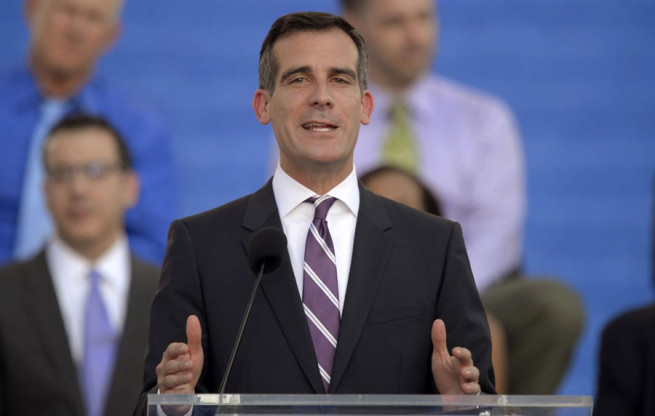Los Angeles Mayor Eric Garcetti is seeking a roughly 25 percent cut in civilian workers’ injury-leave pay, an unusually generous benefit that some believe has contributed to increasing taxes. Along with healthcare and pension costs, injury-leave pay is one of several areas where the city is seeking concessions from labor, the mayor confirmed.
Union representatives are defending the current injury-pay formula, saying the city should not penalize workers who are wounded.
Compensation for job-related injury claims “has to be negotiated at the table,” Garcetti said.
“All of us want a common-sense solution where people don’t have an extra incentive to stay away,” he said Thursday, after a briefing on labor contract talks. “It’s lost productivity, and if you can make more money not being at work, it invites abuse, even though I think most people have legitimate claims.”
Declining to discuss his specific proposal in detail, Mayor Garcetti added that the bargaining process is confidential and acknowledged that the possibility of reductions is not something “many unions have been eager to even entertain.”
An administration source confirmed that the mayor proposed reducing the tax-free pay that non-sworn workers collect while on injury leave—from the current 90 percent for up to a year to about 66 percent, the state-required minimum.
The high city injury-leave benefit is utilized by most custodians, gardeners, office managers and other non-public-safety workers who take home substantially more money while absent recovering from injuries than when working. Under state law, police and firefighters get 100 percent of their salaries tax-free for up to a year while on job-related injury leave.
In a Los Angeles Times investigation from December 2014, the cost to taxpayers for the city’s civilian employees injury leave rose 50 percent in the last five years to $18 million.
Officials said that there is no evidence that the jobs became significantly more dangerous during that period. However, city data shows that the average length of the leaves climbed from just under seven weeks in 2009, to 10 and ½ weeks in 2013. Los Angeles County, which pays its civilian employees less during injury leave, had far lower claims and absences rates.
After the Times report was published last December, Mayor Garcetti said he would explore ways to change the injury-pay policy, which is already written into more than a dozen city union contracts. The cut being sought would save the city about $5 million per year, according to a 2013 audit.
“Workers should not be penalized when they’re injured as a result of their service to the City of Los Angeles,” argued Cheryl Parisi, the chair of the Coalition of LA City Unions, who defended the current leave benefit. “The current policy allows for injured workers to recover and return to work without threat of losing their home or falling behind on bills.”
Parisi said that if the city wants to cut injury leave costs, it should fund an “effective workers’ safety program” and make sure light-duty options are offered to employees unable to perform their normal jobs.
An email circulated last week by the Service Employees International Union to citywide union members cited a list of demands from the mayor, including the proposed cuts to injury leave compensation, and raises the possibility of a strike that they say would leave garbage on the streets, snarl freeway traffic and disrupt flights at LAX.
The message said Garcetti was “writing on his own behalf to gauge union members’ appetite for a dramatic, wide-ranging job action.”
“This will not be your Daddy’s strike,” he wrote. The email questioned how the mayor’s “penny smart” reputation would fare if a strike by city workers led to major problems for the shipping and travel industries.
Garcetti’s comments and the email opened a window on LA’s usually secretive bargaining talks, and the ongoing challenges the mayor faces with LA’s powerful unions.
(With reports from Los Angeles Times)








